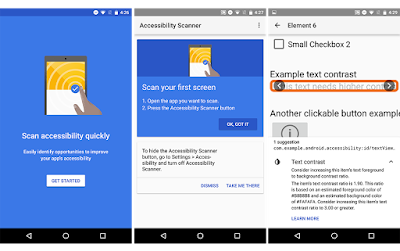New & Improved Accessibility In Google Products
If you use Google products like Android phones or Chromebook, you probably already know how well their accessibility features work. Google is constantly working on improving existing features and adding new ones to make their devices much more accessible and friendly for people with disabilities. Recently, Google introduced several accessibility enhancements to its products, some of which are listed below:
Accessibility Scanner: Accessibility Scanner is a new Android tool that suggests improvements regarding accessibility in Android apps. A user simply selects an app they want to scan and hit the “Accessibility Scanner” button. The tool will then provide improvements and suggestions for the user that may provide accessibility benefits. Suggested improvements can range from enlarging buttons, increasing contrasts to providing content description. These suggestions can be shared with app developers so they could include them in their apps. Developers can run this tool while developing their apps too so they could reach out to a larger audience base that would include people with disabilities.
Edit Google Docs with Voice: Do you use Google Docs extensively for creating word documents (or for writing your novel :))? You can now just speak to Google Docs and it will do all the typing for you. Voice typing can be enabled by selecting “Tools” menu and choosing “Voice Typing”. Voice Typing can type in many languages and understands several accents*. It makes formatting of documents easier with voice commands like “insert table”, “highlight”, “copy”, “start bullet point”, “apply heading 1” and several others.
*Afrikaans, Arabic, Arabic (Algeria), Arabic (Bahrain), Arabic (Egypt), Arabic (Israel), Arabic (Jordan), Arabic (Kuwait), Arabic (Lebanon), Arabic (Morocco), Arabic (Oman), Arabic (Palestine), Arabic (Qatar), Arabic (Saudi Arabia), Arabic (Tunisia), Arabic (United Arab Emirates), Bulgarian, Catalan, Czech, Danish, German, Greek, English (Australia), English (Canada), English (India), English (Ireland), English (New Zealand), English (Philippines), English (South Africa), English (UK), English (US), Spanish, Spanish (Argentina), Spanish (Bolivia), Spanish (Chile), Spanish (Colombia), Spanish (Costa Rica), Spanish (Ecuador), Spanish (El Salvador), Spanish (Spain), Spanish (US), Spanish (Guatemala), Spanish (Honduras), Spanish (Latin America),Spanish (Mexico), Spanish (Nicaragua), Spanish (Panama), Spanish (Paraguay), Spanish (Peru), Spanish (Puerto Rico), Spanish (Uruguay), Spanish (Venezuela), Basque, Farsi, Finnish, Filipino, French, Galician, Croatian, Hindi, Hungarian, Indonesian, Icelandic, Italian, Italian (Italy), Italian (Switzerland), Hebrew, Japanese, Korean, Lithuanian, Malaysian, Dutch, Norwegian, Polish, Portuguese (Brazil), Portuguese (Portugal), Romanian, Russian, Slovak, Slovenian, Serbian, Swedish, Thai, Turkish, Ukrainian, Vietnamese, Chinese (Simplified), Chinese (Traditional), Chinese (Hong Kong), Zulu
Improved Screen reader on Chromebook: Every Chromebook comes with its own built in screen reader. Recent enhancements include a simplified keyboard shortcut model, a new caption panel that displays braille and speech output, and a new set of navigational sounds.
Voice Commands on Android Devices: Recently, Google introduced a new beta feature called Voice Access Beta that is meant for people who cannot navigate their phone options because of their inability to interact with touch screen, which may be due to paralysis, amputation, tremor or other reasons. This feature would allow users to control their phone via voice by speaking commands like “Open Chrome”, “Go Home”, etc. Since this is still in beta, a user has to sign up for testing by downloading the update from here.
Vision Settings in Android N: Android’s upcoming version is currently codenamed Android N. This version of Android will have important accessibility features like magnification, font size, display size, and TalkBack to the welcome screen that appears when a new phone is being set up. This will enable visually impaired users to independently set up their phone the way they like it and activate needed features right from the get go.
To learn more about Google’s accessibility initiatives, visit this link.
Source: Google



Leave a comment